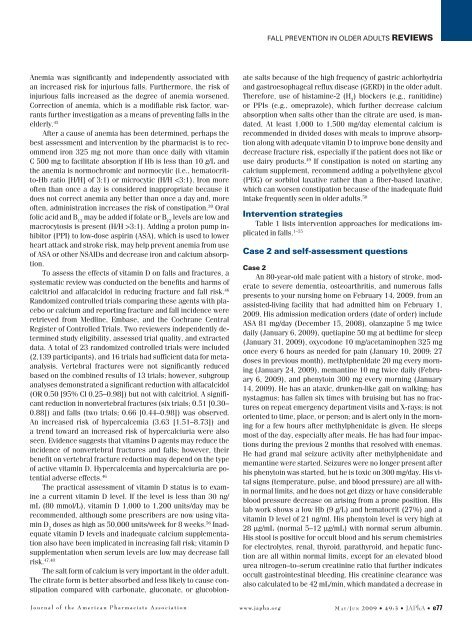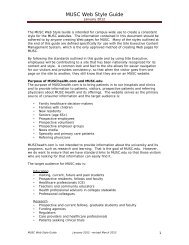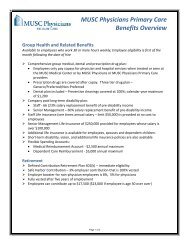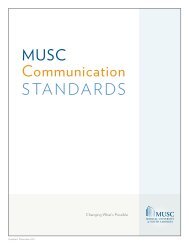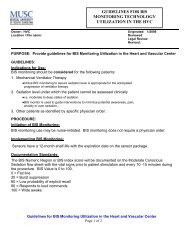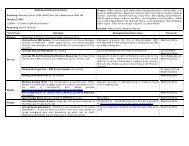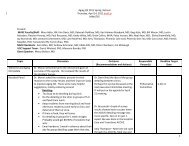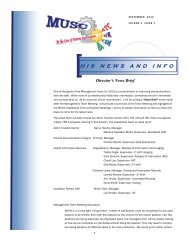"Medication Interventions for Fall Prevention in the Older Adult." J
"Medication Interventions for Fall Prevention in the Older Adult." J
"Medication Interventions for Fall Prevention in the Older Adult." J
You also want an ePaper? Increase the reach of your titles
YUMPU automatically turns print PDFs into web optimized ePapers that Google loves.
<strong>Fall</strong> prevention <strong>in</strong> older adults ReviewsAnemia was significantly and <strong>in</strong>dependently associated withan <strong>in</strong>creased risk <strong>for</strong> <strong>in</strong>jurious falls. Fur<strong>the</strong>rmore, <strong>the</strong> risk of<strong>in</strong>jurious falls <strong>in</strong>creased as <strong>the</strong> degree of anemia worsened.Correction of anemia, which is a modifiable risk factor, warrantsfur<strong>the</strong>r <strong>in</strong>vestigation as a means of prevent<strong>in</strong>g falls <strong>in</strong> <strong>the</strong>elderly. 45After a cause of anemia has been determ<strong>in</strong>ed, perhaps <strong>the</strong>best assessment and <strong>in</strong>tervention by <strong>the</strong> pharmacist is to recommendiron 325 mg not more than once daily with vitam<strong>in</strong>C 500 mg to facilitate absorption if Hb is less than 10 g/L and<strong>the</strong> anemia is normochromic and normocytic (i.e., hematocritto-Hbratio [H/H] of 3:1) or microcytic (H/H 3:1). Add<strong>in</strong>g a proton pump <strong>in</strong>hibitor(PPI) to low-dose aspir<strong>in</strong> (ASA), which is used to lowerheart attack and stroke risk, may help prevent anemia from useof ASA or o<strong>the</strong>r NSAIDs and decrease iron and calcium absorption.To assess <strong>the</strong> effects of vitam<strong>in</strong> D on falls and fractures, asystematic review was conducted on <strong>the</strong> benefits and harms ofcalcitriol and alfacalcidol <strong>in</strong> reduc<strong>in</strong>g fracture and fall risk. 46Randomized controlled trials compar<strong>in</strong>g <strong>the</strong>se agents with placeboor calcium and report<strong>in</strong>g fracture and fall <strong>in</strong>cidence wereretrieved from Medl<strong>in</strong>e, Embase, and <strong>the</strong> Cochrane CentralRegister of Controlled Trials. Two reviewers <strong>in</strong>dependently determ<strong>in</strong>edstudy eligibility, assessed trial quality, and extracteddata. A total of 23 randomized controlled trials were <strong>in</strong>cluded(2,139 participants), and 16 trials had sufficient data <strong>for</strong> metaanalysis.Vertebral fractures were not significantly reducedbased on <strong>the</strong> comb<strong>in</strong>ed results of 13 trials; however, subgroupanalyses demonstrated a significant reduction with alfacalcidol(OR 0.50 [95% CI 0.25–0.98]) but not with calcitriol. A significantreduction <strong>in</strong> nonvertebral fractures (six trials; 0.51 [0.30–0.88]) and falls (two trials; 0.66 [0.44–0.98]) was observed.An <strong>in</strong>creased risk of hypercalcemia (3.63 [1.51–8.73]) anda trend toward an <strong>in</strong>creased risk of hypercalciuria were alsoseen. Evidence suggests that vitam<strong>in</strong>s D agents may reduce <strong>the</strong><strong>in</strong>cidence of nonvertebral fractures and falls; however, <strong>the</strong>irbenefit on vertebral fracture reduction may depend on <strong>the</strong> typeof active vitam<strong>in</strong> D. Hypercalcemia and hypercalciuria are potentialadverse effects. 46The practical assessment of vitam<strong>in</strong> D status is to exam<strong>in</strong>ea current vitam<strong>in</strong> D level. If <strong>the</strong> level is less than 30 ng/mL (80 mmol/L), vitam<strong>in</strong> D 1,000 to 1,200 units/day may berecommended, although some prescribers are now us<strong>in</strong>g vitam<strong>in</strong>D 2doses as high as 50,000 units/week <strong>for</strong> 8 weeks. 56 Inadequatevitam<strong>in</strong> D levels and <strong>in</strong>adequate calcium supplementationalso have been implicated <strong>in</strong> <strong>in</strong>creas<strong>in</strong>g fall risk; vitam<strong>in</strong> Dsupplementation when serum levels are low may decrease fallrisk. 47,48The salt <strong>for</strong>m of calcium is very important <strong>in</strong> <strong>the</strong> older adult.The citrate <strong>for</strong>m is better absorbed and less likely to cause constipationcompared with carbonate, gluconate, or glucobionatesalts because of <strong>the</strong> high frequency of gastric achlorhydriaand gastroesophageal reflux disease (GERD) <strong>in</strong> <strong>the</strong> older adult.There<strong>for</strong>e, use of histam<strong>in</strong>e-2 (H 2) blockers (e.g., ranitid<strong>in</strong>e)or PPIs (e.g., omeprazole), which fur<strong>the</strong>r decrease calciumabsorption when salts o<strong>the</strong>r than <strong>the</strong> citrate are used, is mandated.At least 1,000 to 1,500 mg/day elemental calcium isrecommended <strong>in</strong> divided doses with meals to improve absorptionalong with adequate vitam<strong>in</strong> D to improve bone density anddecrease fracture risk, especially if <strong>the</strong> patient does not like oruse dairy products. 49 If constipation is noted on start<strong>in</strong>g anycalcium supplement, recommend add<strong>in</strong>g a polyethylene glycol(PEG) or sorbitol laxative ra<strong>the</strong>r than a fiber-based laxative,which can worsen constipation because of <strong>the</strong> <strong>in</strong>adequate fluid<strong>in</strong>take frequently seen <strong>in</strong> older adults. 50Intervention strategiesTable 1 lists <strong>in</strong>tervention approaches <strong>for</strong> medications implicated<strong>in</strong> falls. 1–55Case 2 and self-assessment questionsCase 2An 80-year-old male patient with a history of stroke, moderateto severe dementia, osteoarthritis, and numerous fallspresents to your nurs<strong>in</strong>g home on February 14, 2009, from anassisted-liv<strong>in</strong>g facility that had admitted him on February 1,2009. His admission medication orders (date of order) <strong>in</strong>cludeASA 81 mg/day (December 15, 2008), olanzap<strong>in</strong>e 5 mg twicedaily (January 6, 2009), quetiap<strong>in</strong>e 50 mg at bedtime <strong>for</strong> sleep(January 31, 2009), oxycodone 10 mg/acetam<strong>in</strong>ophen 325 mgonce every 6 hours as needed <strong>for</strong> pa<strong>in</strong> (January 10, 2009; 27doses <strong>in</strong> previous month), methylphenidate 20 mg every morn<strong>in</strong>g(January 24, 2009), memant<strong>in</strong>e 10 mg twice daily (February6, 2009), and phenyto<strong>in</strong> 300 mg every morn<strong>in</strong>g (January14, 2009). He has an ataxic, drunken-like gait on walk<strong>in</strong>g; hasnystagmus; has fallen six times with bruis<strong>in</strong>g but has no fractureson repeat emergency department visits and X-rays; is notoriented to time, place, or person; and is alert only <strong>in</strong> <strong>the</strong> morn<strong>in</strong>g<strong>for</strong> a few hours after methylphenidate is given. He sleepsmost of <strong>the</strong> day, especially after meals. He has had four impactionsdur<strong>in</strong>g <strong>the</strong> previous 2 months that resolved with enemas.He had grand mal seizure activity after methylphenidate andmemant<strong>in</strong>e were started. Seizures were no longer present afterhis phenyto<strong>in</strong> was started, but he is toxic on 300 mg/day. His vitalsigns (temperature, pulse, and blood pressure) are all with<strong>in</strong>normal limits, and he does not get dizzy or have considerableblood pressure decrease on aris<strong>in</strong>g from a prone position. Hislab work shows a low Hb (9 g/L) and hematocrit (27%) and avitam<strong>in</strong> D level of 21 ng/ml. His phenyto<strong>in</strong> level is very high at28 µg/mL (normal 5–12 µg/mL) with normal serum album<strong>in</strong>.His stool is positive <strong>for</strong> occult blood and his serum chemistries<strong>for</strong> electrolytes, renal, thyroid, parathyroid, and hepatic functionare all with<strong>in</strong> normal limits, except <strong>for</strong> an elevated bloodurea nitrogen–to–serum creat<strong>in</strong><strong>in</strong>e ratio that fur<strong>the</strong>r <strong>in</strong>dicatesoccult gastro<strong>in</strong>test<strong>in</strong>al bleed<strong>in</strong>g. His creat<strong>in</strong><strong>in</strong>e clearance wasalso calculated to be 42 mL/m<strong>in</strong>, which mandated a decrease <strong>in</strong>Journal of <strong>the</strong> American Pharmacists Association www.japha.org M a y /Ju n 2009 • 49:3 • JAPhA • e77


